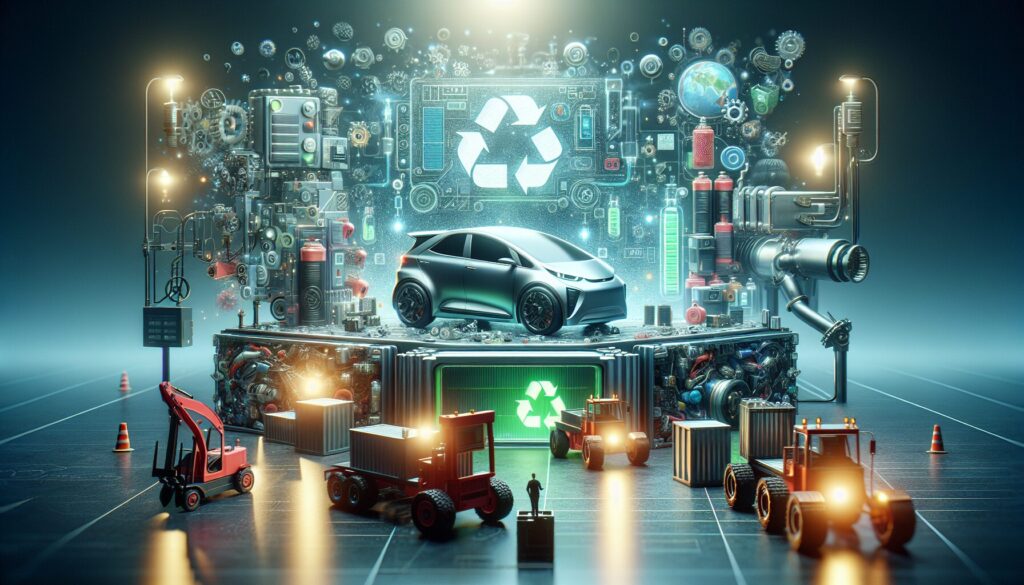Imagine this: your trusty electric car battery has served you well for years, powering your adventures across the UK. But what happens when it can’t quite keep up with your high-speed escapades anymore? Enter the world of second-life applications for these batteries. These batteries are like the heroes of sustainability! After their time in electric vehicles, they can still work wonders. By integrating them with advanced battery management systems (BMS) and using state of charge (SOC) estimation algorithms, they find new life in stationary energy storage systems. Electrochemical impedance spectroscopy (EIS) analysis helps in assessing their health and potential. Companies like Nissan and BMW are leading the charge (pun intended!) in this exciting field. So, instead of bidding farewell to those trusty batteries, we’re giving them a chance to shine again, reducing waste and saving energy. How cool is that?
The Lifecycle of Electric Vehicle Batteries
Isn’t it fascinating how electric vehicle (EV) batteries have a life beyond their initial use? When I first learned about second-life applications for these batteries, I was absolutely hooked. It’s like giving them a whole new purpose. But before we dive into that, let’s chat about the lifecycle of these incredible powerhouses.
Electric vehicle batteries start their journey in the manufacturing phase, where materials like lithium, cobalt, and nickel come together. These materials form the cells that make up the battery packs. Once they’re installed in a vehicle, the real adventure begins. However, the clock starts ticking on their usefulness in powering cars. Over time, their capacity decreases due to factors like charge cycles and temperature variations.
Eventually, an EV battery reaches the end of its automotive life, typically when its State of Health (SOH) dips below 70-80%. This doesn’t mean it’s useless, though. These batteries still have a lot to offer in terms of energy storage. That’s where second-life applications come in, giving them a new role in energy grids or home energy solutions.
Understanding the Transition
Battery Management Systems (BMS) are crucial during the transition from automotive use to second-life applications. They monitor battery health and ensure safe operation. These systems are like the unsung heroes, keeping everything running smoothly. I remember chatting with a friend who works at National Grid, and he explained how BMS can optimize the repurposed batteries’ performance. It’s the kind of tech that makes you appreciate the engineering magic behind the scenes.
Additionally, techniques like Energy throughput analysis help in assessing how much energy the battery can still deliver. This analysis is vital for determining the best second-life application. For instance, some batteries might be better suited for storing solar energy at home, while others could stabilize the grid during peak demand. It’s all about matching capacity with needs.
Second-life usage can extend a battery’s life by another five to ten years. Imagine your old EV battery helping power your home! The environmental benefits are significant, reducing the need for new materials and cutting down on waste. Organizations like British Battery Industry Group are actively exploring these possibilities, pushing the boundaries of what’s achievable with repurposed batteries.
Through innovative methods and technology, electric vehicle batteries continue their journey, contributing to a sustainable future. It’s a beautiful cycle of reuse and efficiency.
Benefits of Repurposing EV Batteries

Imagine having a garage full of electric vehicle batteries just waiting to be repurposed! It’s not a far-fetched idea when you think about the benefits of giving these batteries a second life. You see, electric vehicle (EV) batteries, when they complete their life in a car, still have about 70-80% of their capacity left. This is where the magic of repurposing comes in. It’s like finding a hidden treasure in your attic! So, what exactly are the perks of repurposing these powerhouses?
First off, let’s talk about sustainability. By repurposing EV batteries, we’re reducing the need to mine for new raw materials, which is a huge win for the environment. Mining can be pretty destructive, so anything that decreases our reliance on it is fantastic. Additionally, repurposed batteries can help store renewable energy, like solar or wind, which is a key player in the UK’s push for greener energy solutions. A typical home storage system, for example, can be equipped with a repurposed battery that stores solar energy for use during cloudy days or at night.
Economic Advantages
Economically, it’s a smart move too. Using second-life batteries can be more cost-effective than new storage solutions. This is especially true for large-scale applications, such as grid storage. Companies and individuals can save money while simultaneously supporting sustainable practices. It’s a win-win scenario! Moreover, the integration of these batteries into Battery Management Systems (BMS) is crucial. The BMS ensures the optimized performance and safety of these batteries, prolonging their second life.
From a technical standpoint, second-life applications involve sophisticated State of Charge (SoC) algorithms. These algorithms determine how much energy the battery can store and release. They play a vital role in maximizing the battery’s utility. Additionally, Depth of Discharge (DoD) optimization helps in prolonging the battery’s life by managing how deeply the battery is discharged during use. I remember tinkering with a small solar setup at home, and these technical intricacies made all the difference in efficiency!
On a broader scale, businesses like Nissan are leading the charge in this arena. They’re developing innovative ways to give EV batteries a second lease on life. The UK government is also backing initiatives to boost battery recycling and repurposing, aligning with its goals for a more sustainable future. According to BBC, this effort is part of the country’s commitment to cutting down carbon emissions.
Challenges in Implementing Second-Life Solutions

Oh, the thrill and challenges of giving electric vehicle (EV) batteries a second life! It’s like breathing new life into an old friend. I remember when I first tinkered with repurposing EV batteries for home energy storage. It was a fascinating yet complex journey, especially when it came to integrating the Battery Management System (BMS). This system is crucial for monitoring battery health, State of Charge (SoC), and ensuring safe operation. Without it, you’re navigating uncharted waters without a compass.
One of the biggest hurdles is accurately estimating the remaining capacity of used batteries. These batteries have already seen their glory days in vehicles and can be unpredictable. The algorithms for SoC estimation are critical here. They’re like the secret sauce to figuring out how much juice the battery has left, and trust me, getting that right is an art and science combined.
Additionally, integrating these batteries into grid-tied energy storage systems can be a real head-scratcher. There are a myriad of technical and regulatory challenges. For instance, in the UK, aligning with grid standards and safety regulations can be as complex as piecing together a jigsaw puzzle. It’s essential to work closely with experts and organisations like National Grid to navigate these waters.
Technical and Regulatory Challenges
Furthermore, the integration of second-life batteries into existing infrastructure isn’t always straightforward. Each battery pack can have different specifications from its life in an EV. This means custom solutions for each pack, which can be time-consuming and costly. The BMS must be calibrated to handle various battery chemistries and ensure optimal performance.
On the regulatory side, there are still many grey areas. Standards for second-life applications are still evolving, and this can lead to uncertainty. It’s crucial to stay updated with guidelines from bodies like Office for Product Safety and Standards to ensure compliance and safety.
Moreover, there’s the challenge of consumer perception. People might be cautious about using second-hand batteries, worrying about reliability and safety. It’s up to us enthusiasts to spread awareness and showcase the benefits of these sustainable solutions. After all, reusing EV batteries not only extends their lifecycle but also contributes to a greener planet. So, while the road may be dotted with challenges, the destination is definitely worth the journey!
Innovative Uses for Second-Life Batteries

Second-life applications for electric vehicle batteries are truly fascinating! I remember chatting with a buddy who works in renewable energy, and he was telling me all about the potential of these batteries. You see, when it comes to electric vehicle (EV) batteries, they might not be fit for the road after a certain point, but they’ve still got plenty of juice left in ’em. That’s where the magic happens! By repurposing these batteries, we can unlock new uses while supporting a sustainable future.
One of the coolest applications is using these batteries for energy storage solutions. Imagine this: a solar panel system installed on your roof, soaking up the sun’s rays all day. When the sun goes down, your home can still be powered by the energy stored in second-life batteries. These batteries are integrated into a Battery Management System (BMS) to ensure safe and efficient operation. The BMS monitors the State of Charge (SOC), making sure everything runs smoothly. It’s like having your own mini power station right at home!
Boosting Grid Stability
Now, let’s talk about grid stability. Second-life batteries can also play a crucial role in frequency regulation services. These services help maintain the balance between supply and demand on the national grid. My friend at the National Grid mentioned how these batteries can react quickly to changes in energy demand. They discharge or absorb electricity as needed, helping to stabilize the grid. It’s a win-win situation, boosting reliability and making the most out of what would otherwise be waste.
Another innovative use is in creating off-grid power systems. In remote areas, where access to electricity can be a headache, second-life batteries can provide a reliable and cost-effective solution. By combining these batteries with renewable energy sources like wind or solar, communities can become self-sufficient. It’s a brilliant way of using what we have to improve lives and reduce our carbon footprint.
Finally, these batteries are being put to work in industrial and commercial settings as backup power sources. Businesses often need a reliable power supply to keep operations running smoothly. In the event of a power cut, second-life batteries can kick in and keep everything ticking over. My neighbour, who runs a bakery, installed a backup system using repurposed EV batteries. Not only does it keep the ovens running during outages, but it also saves on energy costs by storing excess electricity generated during off-peak hours.
So, whether it’s powering homes, stabilizing the grid, or supporting businesses, second-life applications for EV batteries are changing the game. Just think of all the potential we have yet to explore! By extending the life of these batteries, we’re making strides toward a greener future. Plus, it feels fantastic to know that we’re making a positive impact on the environment while meeting our energy needs. Exciting stuff, right?
The Future of Battery Second-Life Applications
Imagine a world where electric vehicle batteries, after serving their time under the bonnet, get a second lease on life. It’s not just a sci-fi dream—it’s happening right now! One sunny afternoon, I found myself chatting with a bunch of brilliant engineers at a tech fair in London. We got into the nitty-gritty of State of Health estimation algorithms. These clever algorithms use data to predict how much life is left in a battery after its first gig in an electric vehicle. With this tech, batteries can be repurposed for new roles, like storing energy for the grid or powering small communities. Isn’t that fascinating?
Now, let’s talk about Battery Management System (BMS) integration. BMS is like the brain of the battery. It ensures everything runs smoothly, monitoring temperature, voltage, and current. When electric vehicle batteries find a second life, integrating a robust BMS is crucial. This system optimizes the battery’s performance, extending its usability and ensuring safety. It’s a bit like giving an athlete a top-notch trainer to keep them in peak condition!
Furthermore, second-life applications for these batteries are making waves in grid energy storage. With the UK’s push towards renewable energy, storing surplus energy is more important than ever. Repurposed batteries can store energy generated by solar panels or wind turbines, releasing it when demand peaks. This helps stabilize the grid, reducing reliance on fossil fuels. Isn’t it amazing how something once destined for the scrap heap can become a key player in our energy future?
Community and Environmental Impact
Additionally, these second-life batteries are transforming communities. In some UK neighborhoods, they’ve been used in local energy projects. These projects not only lower energy costs but also promote environmental sustainability. For example, National Grid has been exploring innovative ways to incorporate these batteries into their systems. By doing so, they help reduce carbon footprints and foster energy independence. It’s a win-win for everyone involved!
Moreover, the environmental benefits are significant. Recycling batteries helps reduce waste and minimizes the need for new raw materials. This contributes to a more sustainable future. Organizations like British Battery Technology Centre are at the forefront of these advancements, pushing the boundaries of what’s possible. With ongoing research and development, the potential for these applications is limitless. The future’s looking bright, and I can’t wait to see where this journey takes us next.
Conclusion
In essence, the journey of electric vehicle batteries doesn’t end when they can no longer power cars; it transforms into an opportunity for innovation and sustainability. By embracing second-life applications, we can significantly reduce waste, leverage existing resources for renewable energy storage, and contribute to a cleaner, more efficient future. As we continue to explore and expand these applications, we pave the way for a more sustainable world, one repurposed battery at a time. Keep charging forward towards a greener planet!
Continue Exploring
Ready to transform your understanding of the future of transportation? Dive into cutting-edge innovations with our comprehensive guide to autonomous electric vehicle technologies.
Frequently Asked Questions
What are second-life applications for electric vehicle batteries and how do they work?
Second-life applications for electric vehicle batteries involve repurposing used EV batteries for alternative uses once their capacity drops below a certain threshold for vehicle performance. These applications can include energy storage solutions for homes, businesses, and even grid stabilization. The batteries are reconditioned and reconfigured to store renewable energy, providing a sustainable solution to energy demands and extending the battery’s useful life.
How do second-life electric vehicle batteries contribute to sustainability and environmental conservation?
Second-life electric vehicle batteries play a significant role in sustainability by reducing waste and maximizing resource efficiency. Repurposing these batteries helps decrease the demand for new raw materials and reduces the environmental impact associated with battery disposal. By extending the life of EV batteries through second-life applications, we contribute to a circular economy, supporting renewable energy systems and reducing greenhouse gas emissions.
What are the economic benefits of using second-life applications for electric vehicle batteries?
The economic benefits of using second-life applications for electric vehicle batteries are notable. They provide a cost-effective solution for energy storage, which can lead to lower electricity bills when used in conjunction with renewable energy sources like solar panels. Additionally, by offsetting the need for new battery production, these applications can reduce costs associated with raw material extraction and manufacturing, ultimately offering savings to both consumers and manufacturers.


Leave a Reply